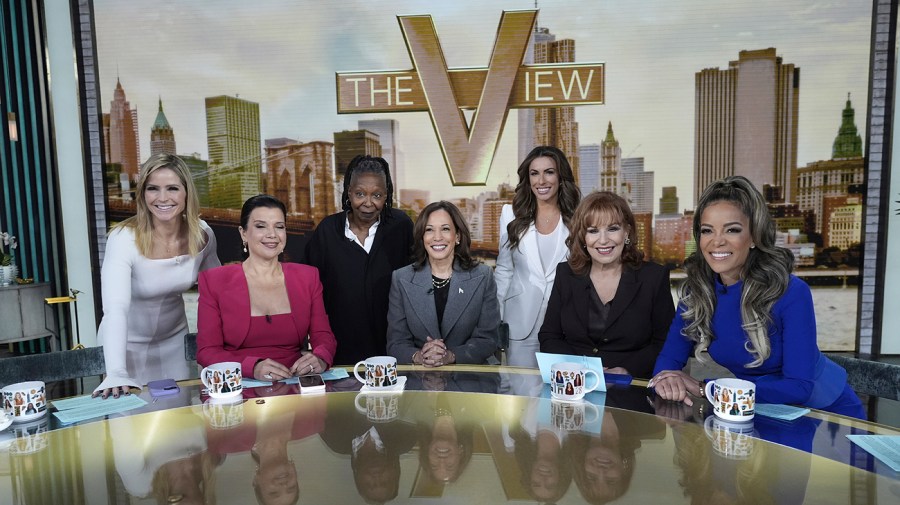Vice President Harris is targeting key voting blocs with her media blitz this week — aiming for television shows and podcasts where she will get in front of seniors, women, Latinos and young voters, and hopefully make a connection.
Harris’s strategy is showcasing an all-of-the-above approach in terms of turning to both traditional media and nontraditional outlets — from influential podcasts like “Call Her Daddy” to “The View” and Howard Stern’s show on SiriusXM satellite radio.
An upcoming town hall with Univision will reach Latino voters, while her appearance on the popular “Call Her Daddy,” which generally is focused on sex and relationships, provides an opportunity to reach out to millennial and Generation Z women.
If the efforts result in just fractions of votes going her way in key states, or in more Democrats coming out to vote, it will be a success in what is shaping up to be an exceptionally tight contest with former President Trump.
“It’s a very smart move. They’re leaving no demographic or audience to chance, and it’s precisely what they should be doing. They’re not just expecting those voters to show up; they’re earning those votes by going where they are and asking for their vote,” said Michael LaRosa, first lady Jill Biden’s traveling press secretary during the 2020 campaign.
Harris has been under pressure to sit down for interviews after not conducting one until roughly a month after becoming the Democratic nominee. Harris has only occasionally taken questions from reporters.
Her new strategy has generally involved sitting down for what are likely to be friendly interviews, though she also did a session with “60 Minutes” where she was pressed on her shifting positions.
While “60 Minutes,” “The View” and Stern’s program largely reach older, more traditional voters, she’s used those visits to target specific issues. On “The View,” Harris outlined a new health care policy proposal to have Medicare help cover the costs of in-home care.
In another out-of-the-box move, Harris recently joined the “All the Smoke” podcast with former NBA players Matt Barnes and Stephen Jackson, which is popular with younger men in particular.
Harris’s running mate, Minnesota Gov. Tim Walz (D), is going on the “SmartLess” podcast, which reaches a large swath of male voters, after going on Fox News on Sunday.
Both of them are doing late-night shows this week, with Harris on “The Late Show with Stephen Colbert” and Walz on “Jimmy Kimmel Live.”
“Harris is doing exactly what she needs to do — talking to voters everywhere. She’s smartly going to where swing voters are, and reaching them where they actually get their news,” said Jim Messina, former President Obama’s 2012 campaign manager.
“And in finding opportunities for voters to get to know more about her, Harris is able to drive a contrast with Trump, who’s been stuck in an echo chamber and only speaking to his own base,” Messina added.
Harris’s appearance on Stern’s show gave Harris a chance to talk about more than politics. While she hit Trump over a report he’d sent COVID tests to Russian President Vladimir Putin, she also recounted eating a bag of Doritos in 2016 when Trump won, described her morning routine, detailed her time caring for her mom when she had cancer and shared her favorite Formula One driver.
With some of the appearances, Harris leaves herself open to criticism that she is mostly talking to friends and supporters. “The View” host Whoopi Goldberg called Harris “the next president of the United States” when she introduced her on the ABC show Tuesday morning.
Trump also leans into friendly interviews, having largely appeared on conservative media since his Sept. 10 debate with Harris. He has spoken with Fox News opinion hosts, podcast hosts such as Ben Shapiro and radio hosts such as Hugh Hewitt.
CBS News’s “60 Minutes” host Bill Whitaker conducted the toughest interview Harris has had since becoming the Democratic nominee, pressing her on issues from how she would pay for her economic plan to why the Biden administration didn’t act sooner to curb the influx of migrants at the border.
Trump declined to participate in “60 Minutes” for its traditional interviews with presidential candidates ahead of the election. The news program addressed the cancellation ahead of airing the Harris interview, saying Trump’s campaign at first agreed to appear and then pulled out.
“60 Minutes” has ranked for decades as a top news program in terms of viewership, and Univision is the most-watched Spanish-language network. “Call Her Daddy” is the second biggest podcast on Spotify, and audience data obtained by NPR showed host Alex Cooper’s listeners are 70 percent women and 93 percent under the age of 45.
The media tour this week comes as Harris leads Trump with 48.9 percent support compared to his 46.5 percent, according to Decision Desk HQ/The Hill’s average of national polls.
A New York Times/Siena College survey released Tuesday found 49 percent of Americans over 65 years old support Harris, compared to 47 percent who support Trump. The two were nearly tied among 45- to 65-year-olds; 48 percent supported Trump and 47 percent supported Harris in the poll.
Among Latinos, Harris’s lead over Trump is the smallest Democrats have seen in recent presidential cycles, according to a recent NBC News/Telemundo/CNBC poll. Among men, Harris only received 41 percent support to Trump’s 57 percent in a recent NPR/PBS News/Marist survey.
“If you look at the state of the election right now, it’s a complete toss-up with possibly an Electoral College edge to Harris right now,” said Jim Kessler, co-founder of the left-center think tank Third Way. “So the final weeks of the campaign is making sure your voters turn out and also persuading the remaining undecideds.”
The post Harris targets critical voting blocs with media blitz appeared first on World Online.

